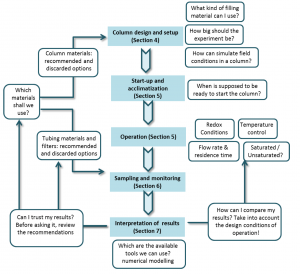Generally, the complexity of natural systems and the multitude of factors influencing removal processes on field scale make it highly unlikely to link certain effects observed in the field to one well-founded parameter. Laboratory studies are preferred for this purpose because experimental conditions can be much better controlled. However, lab studies may result in erroneous or irrelevant results if designed or operated inappropriately. The apparent simplicity of constructing soil-columns conceals a number of technical issues which can seriously affect the outcome of an experiment, such as the presence or absence of macropores, artificial preferential flow paths, non-ideal infiltrate injection and unrealistic moisture regimes. This guidelines review the literature to provide practical recommendations. Common design challenges are discussed and best practices and solutions are presented. The information in this review will assist soil scientists, hydrogeologists and environmental professionals in optimizing the construction and operation of soil-column experiments to assess the behaviour of emerging organic micropollutants (EOCs) in order to achieve their objectives, while avoiding serious design flaws which can compromise the integrity of their results.

